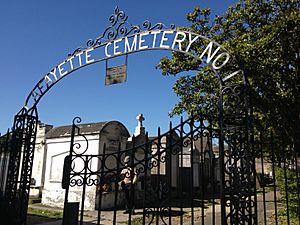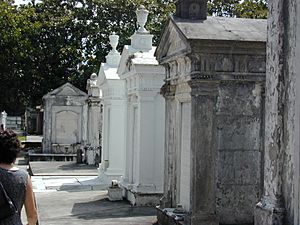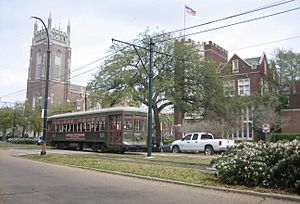Uptown New Orleans facts for kids
Quick facts for kids |
|
|
Uptown New Orleans Historic District
|
|
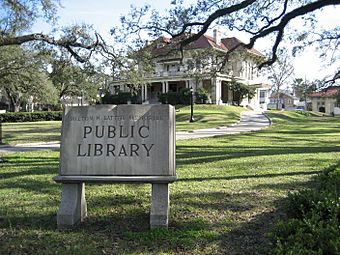
The Latter Memorial Library, a former private mansion built in 1907, sits on the corner of St. Charles Avenue and Soniat St.
|
|
| Lua error in Module:Location_map at line 420: attempt to index field 'wikibase' (a nil value). | |
| Location | New Orleans, Louisiana, United States |
|---|---|
| Architect | Multiple |
| Architectural style | mid-19th-century Revival, late 19th- and 20th-century Revivals, late Victorian, government housing |
| NRHP reference No. | 85001417 |
| Added to NRHP | July 3, 1985 |
Uptown is a lively part of New Orleans, Louisiana. It is located on the east side of the Mississippi River. This area is famous for its beautiful old buildings from the 1800s. Uptown has many homes and small shops. It includes the Uptown New Orleans Historic District, which is a special place listed on the National Register of Historic Places.
Contents
What Are Uptown's Boundaries?
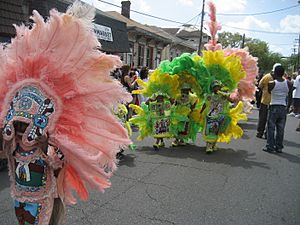
Long ago, "uptown" simply meant moving against the flow of the Mississippi River. After the Louisiana Purchase, many new settlers built homes and businesses in this "upriver" area. In the 1800s, Canal Street was the dividing line. It separated the French-speaking "downtown" from the English-speaking "uptown."
Today, most people in New Orleans think of Uptown as the areas closer to the river. This is generally upriver from the Pontchartrain Expressway and the modern Central Business District.
The official Uptown New Orleans Historic District is listed on the National Register of Historic Places. Its boundaries are the Mississippi River to S. Claiborne Avenue, and Jackson Avenue to Broadway. Other nearby areas often called part of Uptown include the Garden District and Carrollton.
A Look at Uptown's History
Uptown grew during the 1800s. Much of this land used to be large plantations. Several parts of Uptown started as separate towns. These included Lafayette, Jefferson City, and Carrollton. For a long time, most of what is now Uptown was part of Jefferson Parish.
Over time, New Orleans slowly added these towns to its own area. This newly added land became known as uptown New Orleans. People from other parts of the United States moved here in the 1800s. Immigrants from Italy, Ireland, and Germany also settled in Uptown. The area has always had a large African American population. Many city blocks in Uptown were, and still are, home to people from different backgrounds.
The Story of Lafayette City
Small towns grew near steamboat stops a few miles upriver from New Orleans. One of these was the original Lafayette. In 1832, a sugarcane plantation was sold to developers. This land was divided and became the City of Lafayette in 1833. It included the area now known as the Garden District.
Lafayette was also where the first Jefferson Parish courthouse was located. In 1852, New Orleans added Lafayette to its city limits. This moved the city's boundary upriver.
In 1833, a developer named Cornelius Hurst sold land for a cemetery to Lafayette City. This cemetery is now called Lafayette Cemetery No. 1. It is a very old and important place. In 1972, it was added to the National Register of Historic Places.
Greenville and Jefferson City
Greenville was another city that used to be in Jefferson Parish. It was located near the present-day Audubon Park. New Orleans later annexed Greenville, making it part of Orleans Parish.
By 1850, several other small towns had formed. These combined to create Jefferson City. In 1870, New Orleans annexed Jefferson City and other nearby areas. This also included the undeveloped land that would later become Audubon Park.
Early Neighborhoods of Uptown
Hurstville
Faubourg Hurstville was one of the first neighborhoods in what is now Uptown New Orleans. It was created in 1833 by a wealthy businessman named Cornelius Hurst. The land was once part of a plantation. Hurst named three streets after his family: Eleonore, Arabella, and Joseph. He also named a street Nashville, hoping a railroad would build a line there. However, Hurst faced financial problems, and the railroad was not built.
Even though Cornelius Hurst is mostly forgotten, his name lives on with Hurst Street. The name Hurstville is still used today to describe this historic neighborhood. Its streets are mostly residential.
Burtheville
This neighborhood was once farmland owned by Dominique François Burthe. He divided the land in 1851 to create Burtheville. It was located between the river and Claiborne Avenue. In 1858, the United States Marine Hospital was built here. This hospital later became the New Orleans Adolescent Hospital.
Rickerville
Rickerville was created in 1849 and named after Samuel Ricker, one of the landowners. It was located next to Hurstville.
Uptown (Specific Neighborhood)
The term "Uptown" can also refer to a specific neighborhood within the larger Uptown area. This neighborhood is bounded by Napoleon Avenue, Magazine Street, Jefferson Avenue, and La Salle Street. It was once known as Faubourg Bouligny.
Uptown's Cityscape
Uptown was built on higher ground along a natural levee of the Mississippi River. The streets follow the river's curve or run straight from it. This creates a unique "wheel with spokes" street pattern.
Major streets that follow the river's curve include:
- Tchoupitoulas Street: Closest to the river, it used to be for shipping. Now it has more homes and shops.
- Magazine Street: A major shopping area known for its many local shops, restaurants, and art galleries.
- Prytania Street: Another important street, though it doesn't go as far as Magazine Street.
- St. Charles Avenue: Famous for its beautiful old mansions and the St. Charles Avenue streetcar line. Many mansions have been turned into apartments.
- Claiborne Avenue: This wide street was once the back boundary of the developed area.
Important streets that run perpendicular to the river include Jackson, Washington, Louisiana, Napoleon, Jefferson, and Nashville Avenues. Many of these were once the main streets or boundaries of the early towns that became part of New Orleans.
Near the upper end of Uptown, you'll find important landmarks like Audubon Park, Tulane University, and Loyola University.
Neighborhoods in Uptown
Uptown includes several important neighborhoods, moving roughly upriver from Canal Street:
- Central City
- Garden District
- Irish Channel
- Faubourg Bouligny
- Audubon/University District
- Carrollton
- Central Business District
Some people also include areas further back from Claiborne Avenue, like the Broadmoor neighborhood, as part of Uptown.
Famous People from Uptown
Many famous people have lived in Uptown, including:
- Jazz Musicians: Louis Armstrong, Buddy Bolden, Harry Connick Jr., the Neville Brothers, and Joe "King" Oliver.
- Singers: The Boswell Sisters and Mahalia Jackson.
- Writers: Anne Rice and John Kennedy Toole.
- Football Players: Archie Manning and his sons Peyton and Eli Manning, Drew Brees, and Thomas Morstead.
- Rappers: Lil Wayne and Birdman (rapper).
Uptown and Hurricane Katrina
Most of Uptown is on higher ground, so it did not flood much during Hurricane Katrina in 2005. This part of the city was sometimes called "the Sliver by the River" because it was spared. However, some areas closer to Claiborne Avenue did experience severe flooding.
Many old homes in these areas were built on piers to protect against floods. But the water rose even higher than expected. Still, the area closer to the river, especially near St. Charles Avenue, avoided flooding. This was the largest part of New Orleans that was not flooded by the levee breaks.
After Katrina, Magazine Street became a very important commercial area. Many local businesses reopened there before larger chain stores in the city.
Education in Uptown
Uptown has several schools for students. New Orleans Public Schools operates public schools in the district. The Recovery School District oversees charter schools.
Some high schools in the Uptown area include Walter L. Cohen High School, Eleanor McMain Secondary School, and New Orleans Charter Science and Mathematics High School (Sci High). Lusher Charter School is also in Uptown. The Lycée Français de la Nouvelle Orléans, a public French immersion charter school, is also located here.
Catholic schools in the area include St. Katharine Drexel Preparatory School.
Images for kids
-
Mardi Gras Indians, second lines, and Carnival parades are part of Uptown's traditions.


